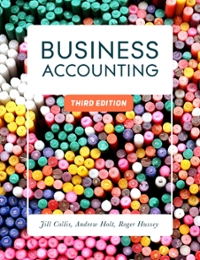Jordan took a business trip from New York to Denver. She spent two days in travel, conducted business for nine days, and visited friends for five days. She incurred the following expenses:
\fMany taxpayers in the United States attribute a large portion of their taxable income to selfemployment trade or businesses. Selfemployment status automatically increases the complexity of a taxpayer's tax return. It also increases the importance of understanding applicable tax law to minimize a taxpayer's tax liability. In this chapter, we present and discuss the tax rules for recognizing income and maximizing expenses on Schedule Cfor self-employed businesses. Learning Objectives When you have completed this chapter, you should understand the following learning objectives (LO): .l LO 6-1 Describe how income and expenses for a selfemployed individual are recognized and reported. I LO 6-2 Explain the concept of ordinary and necessary business expenses. .l LO 6-3 Explain the calculation of depreciation for trade or business assets. .l LO 6-4 Describe travel and entertainment expenses and discuss their deductibility. .l LO 6-5 Apply the rules for deducting the business portion of a residence and business bad debts. .l LO 6-6 Explain the hobby loss rules and the limits on education expense deductibility. .l LO 6-7 Describe the calculation of selfemployment taxes. Changes to this chapter as a result of the Tax Cuts and Jobs Act of 2017 o The bonus depreciation percentage is increased from 50% to 100%. - The Section 179 depreciation deduction limit is increased to $1 million from $500,000. . No deduction is allowed for expenses related to business entertainment, amusement, and recreation. . No deduction is allowed for the cost of providing qualied parking and transportation fringe benets. . Depreciation limits are increased for luxury autos. - Taxpayers are allowed a deduction of 20% of income from a partnership, Subchapter S corporation, or sole proprietorship. Page 6-2 Deduction may be limited based on income. - Hobby losses are no longer deductible. . Home ofce expenses are no longer deductible. uavc1 Lllllc UCLWCCII Uublllcbb uaya auu llUllUuDuleb uayb. 1U calculate LUV UCUUDLIUIC alllUullL U1 lllc lUullU'Lllp llaVCl CAPCIIDUD, 1,115 Page 6_26 taxpayer multiplies total trip costs by the fraction of the number of business days to the total number of travel days outside of the 4. United States. Weekends and holidays that intervene the business days are considered business days.44 If a vacation is taken beyond the place of business activities, the travel deduction is limited to those expenses to and from the business location.45 Deductibility of Meals and Entertainment The Tax Cut and Jobs Act of 2017 repealed any deduction for entertainment expenses. Prior to 2018, these expenses were 50% deductible if directly related or associated with business. The deduction for 50% of food and beverages associated with a trade or business has been retained. In general, any business meals are limited to 50% of the amount incurred. Club dues and membership fees are expressly denied as deductions.46 The taxpayer's meals while away from home on business may be deducted if the taxpayer either keeps track of the actual cost of meals or uses the federal per diem rates. The federal meal and incidental per diem rates vary and depend on the location of the meals and lodging.47 For the tax year 2018, the continental standard per diem (CONUS) rate is $51 for meals and incidentals. These standard amounts are increased for business travel in IRS-designated high-cost areas. Using a per diem rate eliminates the need for detailed recordkeeping. The 50% limit does not apply to selfemployed individuals in certain circumstances.48 Self-employed taxpayers who meet the following three requirements can deduct 100% of meals and entertainment expenses: 1. The taxpayer incurs these expenses as an independent contractor. 2. The customer or client reimburses the taxpayer or gives the taxpayer allowances for these expenses in connection with the services performed. 3. The taxpayer provides adequate records of these expenses to the customer or client. 6 TAX YOUR BRAIN Why does the IRS allow self-employed taxpayers who meet the three requirements to deduct 100% of meals and entertainment expenses? ANSWER If the taxpayer is an independent contractor and the client reimburses him or her for meals and entertainment, the reimbursement would be included in the taxpayer's 1099-MISC from the client and thus be required to be reported in full as income. If the taxpayer is then allowed only a 50% deduction, the extra 50% would remain in taxable income (100% included in income but only 50% deductible) when, in fact, those amounts are expense reimbursements, not income









